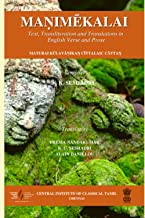 Maṇimēkalai, one of the masterpieces of Tamil literature, gives us, a delightful insight into the ways of life, the pleasures, beliefs, and philosophical concepts of a refined civilization. The story relates the adventures of a dancing girl who becomes a convert to Buddhism. Maṇimēkalai calls into question many of our received ideas concerning ancient India as well as our interpretation of the sources of its present-day religion and philosophy. In its clear accounts of the philosophical concepts of the time, the Maṇimēkalai presents the various currents of pre-Aryan thought (mainly preserved by the Ajivika ascetics and Jain monks) which gradually influenced the Vedic Aryan world and became an essential part of it and, through Buddhism, spread over the whole of the Far East and Central Asia. The society in which the action of the Maṇimēkalai takes place has little to do with the Aryanized civilization of the north which we know from Sanskrit texts. Although important cultural exchanges between the Aryan and Dravidian worlds had already taken place by this time, the latter was still able to maintain its independence, some of its features continuing even to our own times. The centre of religious and political power is the king. As in ancient China, the god’s favour and the country’s prosperity depend on the King’s virtue. Spiritual and religious life is guided by sages, seers (rishis), who lead an ascetic life, living in the mountains or in secluded places. It appears that Dravidian society did not originally possess a priestly caste. However, during the Maṇimēkalai period, groups of Brahmans from the north had already established themselves in villages or parts of the towns, forming separate communities which were treated sometimes with respect and sometimes with hostility. Author Cāttan, the author of the Maṇimēkalai, was a noble merchant well known as a poet and poetry critic and was one of the last members of the Sangam, the famous Academy of Tamil poets, whose beginnings are lost in history. Cāttan was the protégé of King Chera Senguttuvan who, according to Cilappatikāram, The Ankle Bracelet, reigned for more than fifty years and made numerous conquests. He was also a friend of Prince Ilango Adigal, the author of The Ankle Bracelet, whose approval he received for this work, a continuation of that same story. He must also have had the approval of Aravaṇa Aṭikal, the great preacher of Buddhism in south India. The action takes place in the three southern kingdoms, whose dynasties fade into prehistory: in the west, the kingdom of Chera (nowadays Kerala); to the east, Chola or Cholamandala (Coromandel, in the Madras region); and in the south, Pandya, whose capital is Madura. All the data agree in placing the Maṇimēkalai in the second century of our era. Starting from the end of the third century (A.D.295), the dominant power in the south of India belonged to the Pallavas, of Parthian origin, who came from Maratha country and spoke the Maharashtri dialect. They established themselves at Kanchi and subdued the three kingdoms of Chola, Pandya, and Chera. The story is supposed to be a continuation of what has already been superbly treated by Iḷaṅkō. in his Cilappatikāram. Towards the end of the earlier epic, Kaṇṇaki takes revenge upon the Pandya King for having killed her husband unjustly by burning up the city of Madurai. Realising his folly, the king dies of shock; Kaṇṇaki is taken to heaven by some divine beings in a celestial car; Mātavi, the danseuse, joins the Buddhist order along with her daughter Maṇimēkalai. |


